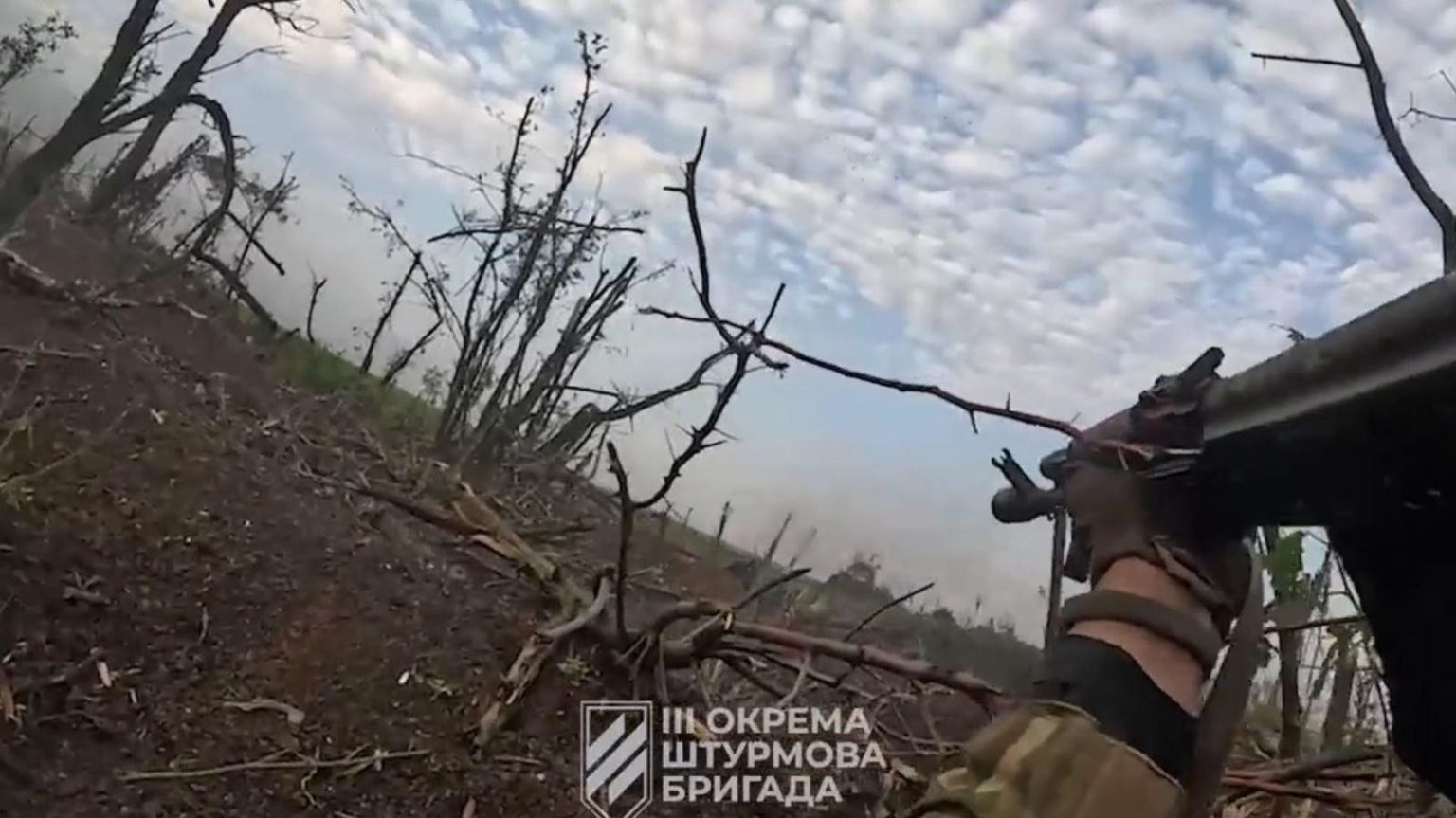One of the Ukrainian army’s newest and most controversial brigades claimed it swept Russian troops from a key defensive position south of Bakhmut late last week.
The 3rd Assault Brigade’s troopers rushed Russian trenches on the western bank of the Donets-Donbas Canal, which threads north to south through eastern Ukraine’s Donbas region and anchors Ukrainian defenses around the ruins of Bakhmut.
The Russian army’s 57th Motor Rifle Brigade had a toehold on the far side of the waist-deep canal until the 3rd Assault Brigade reportedly dislodged the Russian brigade during a close-quarters trench battle that was like something in World War I.
Col. Andrii Biletskyi, the 3rd Assault Brigade’s commander, announced the unit’s tactical victory in a video on or before Sunday. The Ukrainians claimed they killed 30 Russians and captured 10 prisoners. It’s unclear how many casualties the 3rd Assault Brigade suffered.
Some 3rd Assault Brigade troopers went into battle wearing small video cameras on their helmets. Their videos depict a harrowing fight, as 3rd Brigade infantry teams rush into Russian trenches. Shouting to be heard over gunfire and explosions, the Ukrainians work together to clear dugouts in which Russian soldiers are hiding.
Their tactics are familiar ones, if difficult to master. Taking turns covering each other, small teams of Ukrainian infantry advance along the trench network, shooting around corners and tossing grenades into dugouts.
The Ukrainians can be heard giving Russian hold-outs a chance to surrender before grenading them. Not necessarily out of mercy, but because Russian prisoners are a kind of currency with which Kyiv can buy the freedom of Ukrainian prisoners being held in Russia.
For the 3rd Assault Brigade, potential prisoner-exchanges could be deeply personal. The brigade formed around the survivors of the Azov Regiment, which fought in the brutal siege of Mariupol, Ukraine’s port on the Sea of Azov. Russian troops surrounded Mariupol shortly after Russia widened its war on Ukraine in February 2022.
The Azov Regiment and allied forces held out for three months as the Russians effectively demolished the city, killing tens of thousands. When the Russians finally captured Mariupol in May 2022, they also captured thousands of Ukrainian troops, including many Azov members.
In a series of prisoner-exchanges over the following year, Ukrainian officials freed some of the Mariupol veterans. It seems several hundred remain in Russian prisons, however. Every Russian the 3rd Assault Brigade captures could be the ticket home for a member of the brigade’s founding unit.
The Kremlin at times has been reluctant to free Azov veterans, however. In Russian propaganda, all Ukrainian troops are Nazis—but Azov fighters especially are Nazis. Inasmuch as the regime of Russian president Vladimir Putin describes its war on Ukraine as an effort to “denazify” the country, the Azov prisoners are “proof” that Russia is “winning.”
To be very clear, Nazis neither govern Ukraine nor dominate its armed forces. But it’s true that far-right volunteer groups have fought on the Ukrainian side since Russia first attacked Ukraine in 2014. One of these groups, the Azov Battalion, ultimately evolved into the Azov Regiment, which operates under the banner of the Ukrainian national guard.
The army back in December peeled off the regiment’s special operations battalion and formed the 3rd Assault Brigade around it. All that is to say, the 3rd Assault Brigade is a third-generation descendent of the far-right Azov Battalion.
Time alone has diluted the Azov units’ far-right ideology. And the Ukrainian government has subjected each generation to a deliberate process of depoliticization that has included the induction and training of new recruits and the replacement of key leaders.
It’s naive to claim there are no far-right elements in Ukraine’s armed forces—including in the 3rd Assault Brigade. But then, it’s equally naive to claim the Ukrainian army harbors more right-wing extremists than the Russian army does.
In any event, the 3rd Assault Brigade more or less is a normal brigade in an army that has dozens of them. Its 2,000 or so troopers ride in Western-made M-113 and YPR-765 armored personnel carriers. A company of tanks—including a few captured ex-Russian T-90s—supports the three infantry battalions.
The brigade for months has been fighting in eastern Ukraine. When Russian forces finally occupied the ruins of Bakhmut last month, the 3rd Assault Brigade and adjacent units fell back to the Donets-Donbas Canal—then turned and fought.
“Ukraine is holding Russia’s western advances along the line of Donets-Donbas Canal, turning the waterway into an obstacle as part of a deep defensive zone,” the U.K. Defense Ministry reported on May 16.
Now the Ukrainians are counterattacking on Bakhmut’s flanks at the same time that a larger Ukrainian force is attacking along several axes in southern Ukraine. Kyiv’s long-anticipated counteroffensive, which kicked off on June 4, has liberated several key towns in Zaporizhzhia and Donetsk Oblasts.
But in some sectors, the counterattacking Ukrainians ran into stiffer-than-expected Russian defenses. An armored assault by the Ukrainian army’s 33rd Mechanized Brigade and 47th Assault Brigade ended in disaster south of Mala Tomachka on June 8 when the brigades’ Leopard 2 tanks, M-2 fighting vehicles and special breaching vehicles got stuck in a minefield.
Heavy losses apparently compelled the Ukrainian counteroffensive corps to pause last week in order to reset and revise its plans. The 3rd Assault Brigade’s seemingly successful clearing operation on the western bank of the Donbas Canal signals the counteroffensive’s resumption—and new, more aggressive Ukrainian methods in some sectors.
“Ukrainian forces are using the experiences from the first two weeks of the counteroffensive to refine tactics for assaulting the deep, well-prepared Russian defenses,” the U.K. defense ministry stated. “Ukrainian units are making gradual but steady tactical progress in key areas.”
Read the full article here





